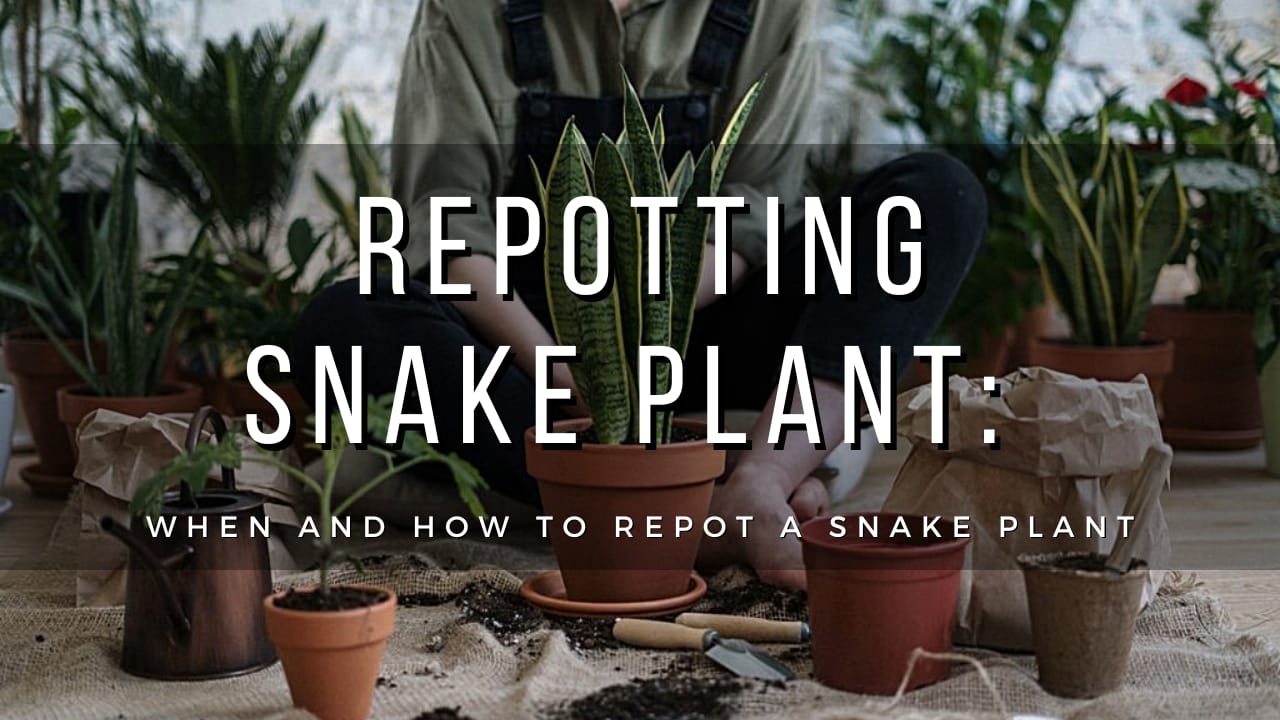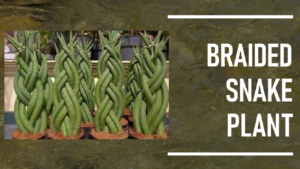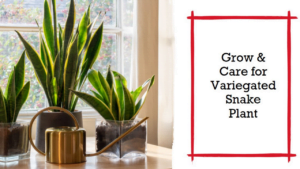Do you know snake plants are known for their beautiful green arching leaves?
These leaves stand tall, creating a focal point in the room.
You won’t be surprised that snake plants are among the most popular houseplants and are low on maintenance. But what if one day you saw your pot cracking up? You might be confused about what to do next.
Are you debating on how to repot snake plants? When to repot snake plant? Or will repotting snake plants cause harm? You might be stressed about how your plant will adjust to its new home. Don’t worry! If this is the case, you are in the right place.
Proper repotting allows your snake plants’ roots to grow, resulting in a healthy plant! But before that, in this article, today you will learn everything like why you should repot your snake plant when to repot a snake plant, how to check if your snake plant needs repotting, how many times you should repot, which is the ideal pot size needed, what is the best soil mix for your snake plants, and the important care tips you must follow for your snake plants! So, keep reading till the end and make sure you don’t miss out on anything!
Why should you repot your snake plant?

Like all other plants and trees, snake plants will outgrow their existing pot or container. The roots of a snake plant will run out of room to grow, and it will become root bound.
Suppose you take your plant out of the container and evaluate its roots. You may notice roots circling the edges. They will form a thick mat at the pot’s base over time.
Some other problems may arise, like wilting, yellow, and brown leaves. It will restrict its growth and ability to survive in the long run.
Repotting snake plants will result in healthy green leaves. Now the question arises, when should you repot snake plants?
When should you repot a snake plant?

You can repot snake plants in the late winter or early spring. It will allow the plant to adapt to its new home and spend the summer growing.
However, if you see your plant’s condition getting worse, you don’t have to wait for the late winter or early spring. You can do it at any time of year if necessary.
Start by evaluating your snake plants. When the roots begin to creep through your pot’s drainage holes, you’ll know it’s time for repotting snake plants.
Plastic pots may begin to bulge. While watering your plants, the water will pass down the drainage hole, and the soil won’t hold them.
How to check if your snake plant needs repotting?
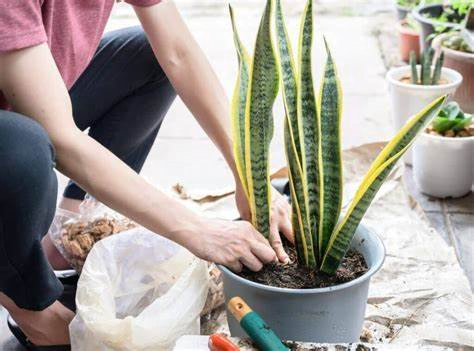
Hold your plant’s base and gently turn it over. Does the plant appear stuck, or does it slide out easily? If it’s stuck, it’s time to get it into something a little bigger.
Now it’s time to wear your Sherlock glasses and examine the roots. Are roots curled up? Are they all over the place and taking over the drainage hole?
While the mother-in-law’s tongue enjoys being rootbound, it struggles when all that’s left are roots. If you see any of the problems which I mentioned above, you should repot snake plant.
How many times should you repot snake plant?
It solely depends upon the growth and container size of your snake plant. On average, you can do it every 2 years. Although, they won’t mind if you repot every 3-5 years with plenty of room to spread.
Remember that snake plants prefer to be slightly pot-bound, so avoid repotting unless they require more space to grow healthily.
Now I will discuss the signs of repotting snake plants in detail.
Signs That Your Snake Plant Needs Repotting!

Several signs could indicate that your snake plant needs repotting. However, if your plant does not genuinely require repotting, don’t do it. It may cause unnecessary stress and chaos for the plant to handle.
1) Your roots are sprouting from the drainage holes
It is a significant warning that your plants need immediate repotting. If the roots of the snake plants are growing out of the drainage holes, you perform a repotting.
It indicates that your pot has filled with roots. They have no room to grow and are forcing themselves to create their way out of the hole.
The snake plant roots’ are overcrowded, making it difficult for them to absorb water and nutrients from the soil. If you leave your pot unattended at this point, it will restrict growth and will die soon.
You should gather your materials and begin repotting as soon as you notice roots creeping out the drainage holes.
2) The soil drains excessively quickly
If your pot is draining too quickly, you should repot the snake plant. The water may be running out of the bottom immediately rather than saturating the soil, which will not produce a healthy plant.
Water draining too quickly from the pot indicates poor soil quality. You might be using the wrong soil for your snake plan, or it has lost its structure over a long period.
The soil begins to lose its nutrients over time as a result of frequent watering and root growth. It can no longer hold water and thus cannot deliver them to the plant’s roots.
Another possible reason for this is overcrowded roots. The roots take up all of the available space, leaving less and less for soil. When there is less soil to hold water, it will run out of the sides.
Even if your plant hasn’t outgrown its existing pot, it is a clear sign that your green friend needs fresh soil and repotting.
3) The pot is breaking up
If you witness the sides and bottom of your pot cracking up, it has reached its extreme point. Sometimes, snake plants grow vigorously and take up so much space that the pot it’s in cracks open.
The rhizomes can push the edges and distort the shape of the pot to the point of cracking. Although snake plants can tolerate some overcrowding, they cannot survive in a cracked pot.
The roots will grow all over the place breaching the soil layers. You should repot snake plants in a one or two size bigger container.
4) There are several pups on the snake plant
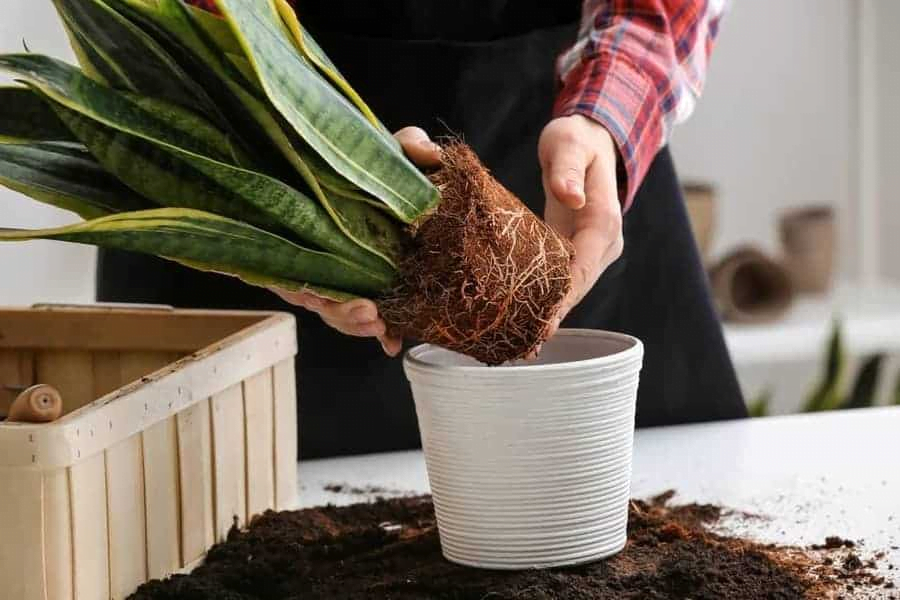
Snake plants extend by sending out new shoots, also known as pups, from the plant’s base. These appear to be tiny snake plants that emerge from the soil near the plant. A rhizome links them.
Although you don’t need a snake plant repotting in a single pup, several pups can be an issue. A plant with many pups will become too crowded. So, you should give your snake plant a little more room to grow.
When repotting, you should select a pot that is one or two sizes larger than the existing one. A pot with extra space will retain too much water, which will cause root rot. As I mentioned above, snake plants don’t require frequent repotting. These green beauties will be happy in the same pot for 2-3 years.
Now that you know all the possible signs for repotting snake plants, let’s move forward. For repotting, which is the ideal pot?
Which is the ideal pot size for snake plants?

Generally, snake plants prefer to grow in slightly tight pots. While repotting, you can increase the pot size by one or two maximum.
For example, if you have an existing pot of 5 inches, you can choose 6-7″ would be ideal. Ideally, 7″ would be best for a growing pot.
If you are going too big, it can hamper the growth of the snake plant. It can increase water retention and the risk of root rot. While choosing a pot, make sure to pick one with drainage holes.
If your plant has fuller growth, you should choose a wider pot rather than a taller one. When it comes to material, ceramic or terracotta would be an excellent pick.
Now the next thing you should consider in repotting snake plants is the type of soil. Soil can make or break the plant. You should choose the right soil for healthy growth.
What is the best Soil Mix for Snake Plants?
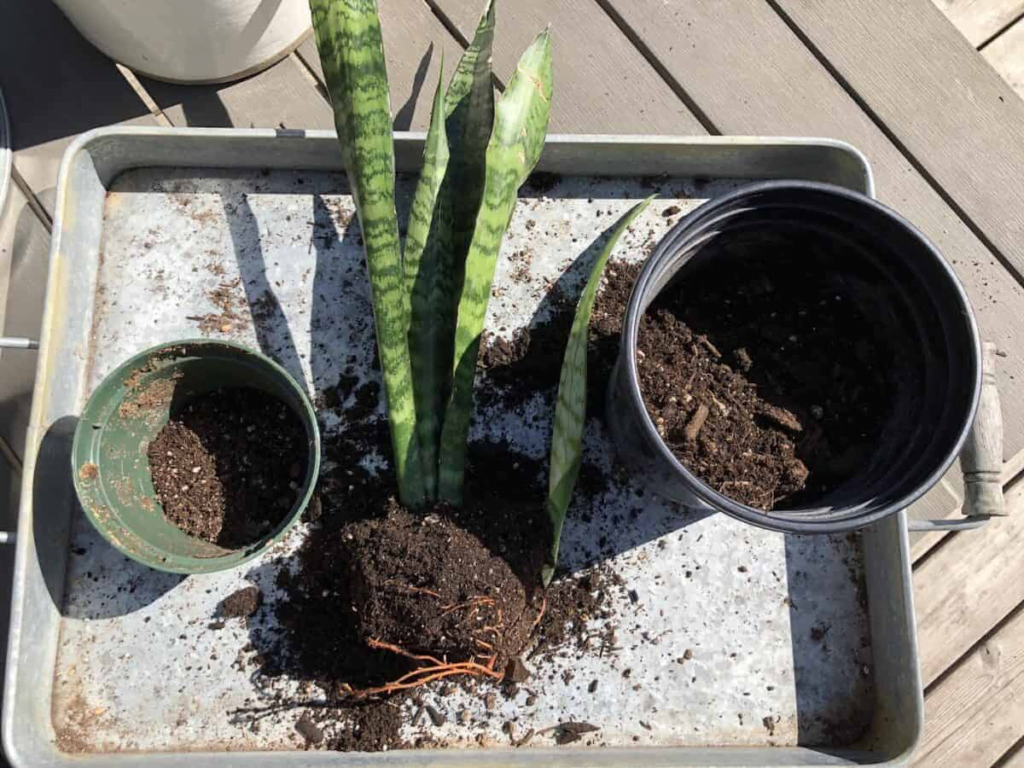
Snake plants don’t like to sit in water for a long time. As a result, choose a well-draining soil mix to keep snake plants happy.
You should go with the well-aerated soil mix, with good drainage and full of nutrients. Although snake plants can be grown in regular houseplant potting soil, they won’t drain well. In this case, you can add more perlite or sand to a pre-mixed potting mix to improve drainage.
You can also go for succulents and cacti soil mixes for them to thrive well. These mixtures, however, may not hold enough water. To counter this situation, you can add a sufficient amount of peat moss or coco coir to increase the water-holding capacity.
I don’t know about you but I just love to DIY the potting soil mixture for my indoor plants. You can add the ingredients that you already have in your home or you can just buy them if available in the market. It’s not rocket science, you can just do it on your own if you follow the steps I have given below!
You can also make your own snake plant potting soil to repot them. I have given two methods below, make sure to check them before you repot your snake plants!
Method 1
- Take one part of a regular potting mix.
- Combine it with one part succulent/cacti mix to make a superior snake plant potting mix.
Method 2
You should mix the following ingredients to make your potting soil for your snake plant.
- 3 tbsp coco coir or peat moss
- 1 part perlite,
- 1 part sand
Now without further delay, let’s move to how to repot snake plants.
How can you repot a snake plant?

Repotting snake plants can assist in healthier green growth. The roots of the plant will have enough room to expand and grow. Before snake plant repotting, you should clean your tools and the pot.
Do you know how to repot a snake plant perfectly? Check out the steps that I have given below if you want a perfectly repotted snake plant without causing any harm to them!
Step 1: Collect Your repotting materials
Rather than going again for the materials to repot the snake plant, collect them at a single place for your convenience.
Things you should have for repotting snake plants:
- Potting Mix
- Pot
- Gardening tools
Your snake plant pot should have a drainage hole so that water can drain effectively. You can choose any pot, but unglazed terra cotta would be preferable if you habit overwater your plant. The breathable clay will allow water to evaporate quickly from the soil.
If your snake plant is severely root-bound, you may need a gardening knife and other tools to assist you in repotting. It will help to loosen the root mass’s edges.
Step 2: Prepare the growing medium (pot)
Clean and fill the new pot with the potting mix. Depending upon the size of the growing medium, fill the pot accordingly.
If you have a taller green snake plant, you should only fill the bottom 1/4 inches or so. These plants have shallow roots, which can cause them to be top-heavy, so settling yours deeper in its pot can help it stay balanced in the same spot.
Step 3: Remove the Snake Plant from the existing container
It is where you need to use your gardening tools with care. Make sure not to harm the plant while repotting the snake plant. Sink your gardening knife into the soil and use a saw to cut around the pot’s edges to free a stubborn root mass.
Then, tilt the existing pot over and slide the roots out. If you are not able to do so, you can tap the pot from the sides. It will help the snake plant to get out.
Step 4: Clean the Roots
When it comes time to repotting snake plants, the roots are usually packed up. If you face the same issue while repotting, spread the roots out a little. Gently untangle the roots as much as possible so they can expand once they’re in their new home.
What to do exactly?
Use your fingers and untangle the clump of roots. Gently pull them out toward the edges.
Step 5: Place Your Snake Plant in the new pot
Place your plant in the new growing medium and fill it with the potting mix. Don’t pack it too tightly; instead, gently pat it down and shake the pot until the gaps are closed.
If you’re repotting because your Snake Plant has root rot, you should prune the roots up to 30%. You should also clean the roots thoroughly and add new potting soil. Make sure not to use any infected soil.
Step 6: Water your plant and leave it to rest
Make sure to water your green snake plant after repotting it into its new home. You should give your plant enough time to adjust to the new change.
Plants are not well adapted to being uprooted and moved to a new location. It’s not something they experience often! No matter how gentle you have been with your Snake Plant, it will have a significant impact on your snake plant.
It is also possible that over the next couple of weeks, you may encounter some problems, such as drooping or wrinkling leaves. You should not worry about this as it is a normal phase. They will go through this process, and you don’t need to add any further stress.
So the ultimate thing you should consider next is their care after repotting. You might be questioning yourself, “How can I make my snake plant comfortable? Or What are the do’s and don’ts after repotting a snake plant.” In the following section, I will talk about repotting aftercare. Let’s get into the details.
How to care for a snake plant after Repotting?
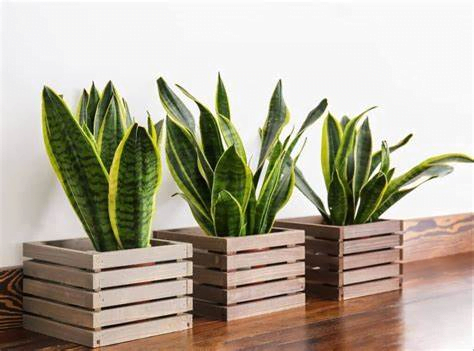
After repotting, your snake plant experiences a shock. You need to give your green beauty extra care and attention to adjust well to the new home. It is critical to avoid transplant shock, especially if you have to trim rotten roots. You should not make any significant changes in the plant after repotting. Check out the steps below on what to do after repotting your beloved snake plants!
- Sunlight: Usually, snake plants can withstand the full sun. However, choose bright but indirect light for at least a month after snake plant repotting. It is less of an issue if you transplant in late winter or early spring when the sunlight is not as intense.
- Location: Do not change the place of the snake plant frequently and let it be at a place for some time. Changing places now and then can cause excessive stress for them to bear.
- Fertilizer: You should strictly avoid fertilizing your snake plant for at least a month. Leaving the plant alone for some time will help them to adjust to the new changes. Fertilizing after repotting snake plants can cause root burn. It is the last thing you want with your plant right now!
- Water: As I already told you, snake plants don’t need a lot of water to survive. So water them only when the topmost layer of the soil is completely dry. Strictly avoid overwatering them.
If you have unintentionally overwatered your plant, drain away the excess water in a saucer that is kept under the pot. A huge amount of moisture promotes root decay.
Frequently Asked Questions
Ques 1: Is it necessary to soak my snake plant before repotting it?
Ans: No, you should not soak your plant before repotting. Snake plants prefer dry soil, and they will do best without soaking.
Ques 2: Should I use a much bigger pot while repotting snake plants?
Ans: No. The size of the growing medium (pot or container) entirely depends upon the growth and size of the snake plant. You should always go for a one or two-size bigger pot. Using a much bigger pot can restrict growth and cause root decay.
Ques 3: Can I water my snake plant after repotting?
Ans: Yes, you should water a snake plant after repotting, but wait for at least two inches down before giving it another drink.
Ques 4: Can I grow two snake plants in a single pot or container?
Ans: Yes, you can as long as it is large enough to accommodate their size.
Ques 5: Why is my snake plant still droopy after repotting?
Ans: It could be a sign of overwatering or underwatering. Remember that snake plants prefer dry soil, but not completely dry soil. In case of underwatering, you should give it a good drink.
Ques 6: Can I mist my snake plant after repotting? Will it create any issues?
Ans: No, you should not miss your snake plant. They prefer moderate humidity, just like you have in a regular home. Misting may cause diseases.
Conclusion
Snake Plants do not require repotting very often, but you need to do it after 3-5 years, depending upon the growth and size. You should use well-draining soil, choose the right pot size, and care for the snake plant after repotting.
If you struggle to maintain beautiful indoor plants, you can always prefer our website for more articles like this. If you have any questions in mind, feel free to comment down below. I know it’s too much to ask but still, if you could share this article on social media, with your friends and family, which will help to reach this article to the masses and help plant lovers like you and me!
Happy Gardening to you!

